+ Open data
Open data
- Basic information
Basic information
| Entry | Database: PDB / ID: 7cr0 | |||||||||||||||||||||||||||
|---|---|---|---|---|---|---|---|---|---|---|---|---|---|---|---|---|---|---|---|---|---|---|---|---|---|---|---|---|
| Title | human KCNQ2 in apo state | |||||||||||||||||||||||||||
 Components Components | Potassium voltage-gated channel subfamily KQT member 2 | |||||||||||||||||||||||||||
 Keywords Keywords | TRANSPORT PROTEIN / ion channel | |||||||||||||||||||||||||||
| Function / homology |  Function and homology information Function and homology informationaxon initial segment / Voltage gated Potassium channels / node of Ranvier / voltage-gated monoatomic cation channel activity / Interaction between L1 and Ankyrins / ankyrin binding / action potential / voltage-gated potassium channel activity / voltage-gated potassium channel complex / potassium ion transmembrane transport ...axon initial segment / Voltage gated Potassium channels / node of Ranvier / voltage-gated monoatomic cation channel activity / Interaction between L1 and Ankyrins / ankyrin binding / action potential / voltage-gated potassium channel activity / voltage-gated potassium channel complex / potassium ion transmembrane transport / nervous system development / chemical synaptic transmission / calmodulin binding / synapse / membrane / plasma membrane Similarity search - Function | |||||||||||||||||||||||||||
| Biological species |  Homo sapiens (human) Homo sapiens (human) | |||||||||||||||||||||||||||
| Method | ELECTRON MICROSCOPY / single particle reconstruction / cryo EM / Resolution: 3.1 Å | |||||||||||||||||||||||||||
 Authors Authors | Li, X. / Lv, D. / Wang, J. / Ye, S. / Guo, J. | |||||||||||||||||||||||||||
| Funding support |  China, 2items China, 2items
| |||||||||||||||||||||||||||
 Citation Citation |  Journal: Cell Res / Year: 2021 Journal: Cell Res / Year: 2021Title: Molecular basis for ligand activation of the human KCNQ2 channel. Authors: Xiaoxiao Li / Qiansen Zhang / Peipei Guo / Jie Fu / Lianghe Mei / Dashuai Lv / Jiangqin Wang / Dongwu Lai / Sheng Ye / Huaiyu Yang / Jiangtao Guo /  Abstract: The voltage-gated potassium channel KCNQ2 is responsible for M-current in neurons and is an important drug target to treat epilepsy, pain and several other diseases related to neuronal hyper- ...The voltage-gated potassium channel KCNQ2 is responsible for M-current in neurons and is an important drug target to treat epilepsy, pain and several other diseases related to neuronal hyper-excitability. A list of synthetic compounds have been developed to directly activate KCNQ2, yet our knowledge of their activation mechanism is limited, due to lack of high-resolution structures. Here, we report cryo-electron microscopy (cryo-EM) structures of the human KCNQ2 determined in apo state and in complex with two activators, ztz240 or retigabine, which activate KCNQ2 through different mechanisms. The activator-bound structures, along with electrophysiology analysis, reveal that ztz240 binds at the voltage-sensing domain and directly stabilizes it at the activated state, whereas retigabine binds at the pore domain and activates the channel by an allosteric modulation. By accurately defining ligand-binding sites, these KCNQ2 structures not only reveal different ligand recognition and activation mechanisms, but also provide a structural basis for drug optimization and design. | |||||||||||||||||||||||||||
| History |
|
- Structure visualization
Structure visualization
| Movie |
 Movie viewer Movie viewer |
|---|---|
| Structure viewer | Molecule:  Molmil Molmil Jmol/JSmol Jmol/JSmol |
- Downloads & links
Downloads & links
- Download
Download
| PDBx/mmCIF format |  7cr0.cif.gz 7cr0.cif.gz | 206.6 KB | Display |  PDBx/mmCIF format PDBx/mmCIF format |
|---|---|---|---|---|
| PDB format |  pdb7cr0.ent.gz pdb7cr0.ent.gz | 154.4 KB | Display |  PDB format PDB format |
| PDBx/mmJSON format |  7cr0.json.gz 7cr0.json.gz | Tree view |  PDBx/mmJSON format PDBx/mmJSON format | |
| Others |  Other downloads Other downloads |
-Validation report
| Summary document |  7cr0_validation.pdf.gz 7cr0_validation.pdf.gz | 874.7 KB | Display |  wwPDB validaton report wwPDB validaton report |
|---|---|---|---|---|
| Full document |  7cr0_full_validation.pdf.gz 7cr0_full_validation.pdf.gz | 881 KB | Display | |
| Data in XML |  7cr0_validation.xml.gz 7cr0_validation.xml.gz | 30.3 KB | Display | |
| Data in CIF |  7cr0_validation.cif.gz 7cr0_validation.cif.gz | 42 KB | Display | |
| Arichive directory |  https://data.pdbj.org/pub/pdb/validation_reports/cr/7cr0 https://data.pdbj.org/pub/pdb/validation_reports/cr/7cr0 ftp://data.pdbj.org/pub/pdb/validation_reports/cr/7cr0 ftp://data.pdbj.org/pub/pdb/validation_reports/cr/7cr0 | HTTPS FTP |
-Related structure data
| Related structure data |  30443MC  7cr1C  7cr2C  7cr3C  7cr4C  7cr7C M: map data used to model this data C: citing same article ( |
|---|---|
| Similar structure data |
- Links
Links
- Assembly
Assembly
| Deposited unit | 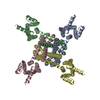
|
|---|---|
| 1 |
|
- Components
Components
| #1: Protein | Mass: 73627.812 Da / Num. of mol.: 4 Source method: isolated from a genetically manipulated source Source: (gene. exp.)  Homo sapiens (human) / Gene: KCNQ2 / Cell line (production host): HEK293 / Production host: Homo sapiens (human) / Gene: KCNQ2 / Cell line (production host): HEK293 / Production host:  Homo sapiens (human) / References: UniProt: O43526 Homo sapiens (human) / References: UniProt: O43526Has protein modification | N | |
|---|
-Experimental details
-Experiment
| Experiment | Method: ELECTRON MICROSCOPY |
|---|---|
| EM experiment | Aggregation state: PARTICLE / 3D reconstruction method: single particle reconstruction |
- Sample preparation
Sample preparation
| Component | Name: voltage-gated potassium channel KCNQ2 / Type: COMPLEX / Entity ID: all / Source: RECOMBINANT |
|---|---|
| Source (natural) | Organism:  Homo sapiens (human) Homo sapiens (human) |
| Source (recombinant) | Organism:  Homo sapiens (human) Homo sapiens (human) |
| Buffer solution | pH: 8 |
| Specimen | Embedding applied: NO / Shadowing applied: NO / Staining applied: NO / Vitrification applied: YES |
| Vitrification | Cryogen name: ETHANE |
- Electron microscopy imaging
Electron microscopy imaging
| Experimental equipment |  Model: Titan Krios / Image courtesy: FEI Company |
|---|---|
| Microscopy | Model: FEI TITAN KRIOS |
| Electron gun | Electron source:  FIELD EMISSION GUN / Accelerating voltage: 300 kV / Illumination mode: FLOOD BEAM FIELD EMISSION GUN / Accelerating voltage: 300 kV / Illumination mode: FLOOD BEAM |
| Electron lens | Mode: BRIGHT FIELD |
| Image recording | Electron dose: 1.556 e/Å2 / Film or detector model: GATAN K2 SUMMIT (4k x 4k) |
- Processing
Processing
| Software | Name: PHENIX / Version: 1.15.2_3472: / Classification: refinement | ||||||||||||||||||||||||
|---|---|---|---|---|---|---|---|---|---|---|---|---|---|---|---|---|---|---|---|---|---|---|---|---|---|
| EM software | Name: PHENIX / Category: model refinement | ||||||||||||||||||||||||
| CTF correction | Type: PHASE FLIPPING AND AMPLITUDE CORRECTION | ||||||||||||||||||||||||
| 3D reconstruction | Resolution: 3.1 Å / Resolution method: FSC 0.143 CUT-OFF / Num. of particles: 145412 / Symmetry type: POINT | ||||||||||||||||||||||||
| Refine LS restraints |
|
 Movie
Movie Controller
Controller








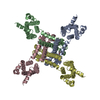
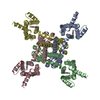
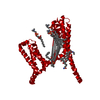
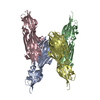
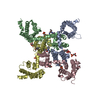

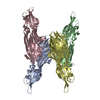
 PDBj
PDBj
